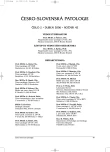Mammary Carcinoma with Osteoclast-like Giant Cells – Report of Two Cases
Mamárny karcinóm s osteoklastoidnými obrovskými bunkami – opis dvoch prípadov
Opísané sú dva prípady vzácneho typu mamárneho karcinómu u 47- a 49-ročných pacientiek, ktorý je charakteristický výskytom osteoklastoidných obrovských buniek, hypervaskulárnou strómou, nálezom starších a čerstvých krvácaní na pozadí bežných typov karcinómov prsnej žľazy. V oboch prípadoch išlo o stredne diferencovaný konvenčný duktálny invazívny karcinóm, v ktorom sa tak v stróme, ale aj priamo v nádorovej populácií nachádzali roztrúsené obrovské viacjadrové bunky osteoklastoidného typu. Imunohistochemická analýza (pozitivita vimentínu a CD68 a negativita cytokeratínov, EMA a S100) podporila histiocytárny pôvod týchto buniek, ktoré majú reaktívny a nie nádorový charakter. Klinické a morfologické črty svedčia pre to, že tento typ karcinómu tvorí samostatnú klinicko-histomorfologickú jednotku s pravdepodobne lepšou prognózou ako konvenčný duktálny invazívny karcinóm a vo svojej klasickej podobe by nemal byť zaraďovaný medzi metaplastické karcinómy.
Kľúčové slová:
karcinóm – prsná žľaza – osteoklastoidný – imunohistochémia
Authors:
K. Kajo; K. Macháleková; Z. Kviatkovská
Authors‘ workplace:
Ústav patologickej anatómie Jesseniovej lekárskej fakulty
a Martinskej fakultnej nemocnice, Martin, Slovenská Republika
Published in:
Čes.-slov. Patol., 42, 2006, No. 2, p. 71-75
Category:
Overview
Authors describe two cases of a rare type of mammary carcinoma occurring in 47-year and 49-yearold women, characterised by osteoclast-like giant cells, hypervascular stroma, and signs of older and recent haemorrhages on the background of the conventional type of breast carcinoma. In both cases there was diagnosed moderately differentiated ductal invasive carcinoma with osteoclastlike giant cells, which were present in tumorous stroma as well as scattered between tumorous cells. Immunohistochemical analysis (vimentin and CD68 positivity and negativity of cytokeratins, EMA and S-100 protein) confirmed a histiocytic origin of these giant cells as well as their reactive non-neoplastic nature. Clinical and morphological features of this unusual type of breast carcinoma indicate that it should be regarded as an unique clinical- histomorphological entity with probably better prognosis when compared to ductal invasive carcinoma not otherwise specified and it should not be included among metaplastic breast carcinomas.
Key words:
breast – carcinoma – osteoclast-like – immunohistochemistry
Labels
Anatomical pathology Forensic medical examiner ToxicologyArticle was published in
Czecho-Slovak Pathology

2006 Issue 2
Most read in this issue
- Argyrophilic Grain Disease: Case Report of the First Two Cases in the Czech Republic and Review of the Literature
- Tumoriform Endometriosis of the Urinary Bladder in Advanced Pregnancy
- Dedifferentiated Mixed Stromal-Smooth Muscle Tumor of the Uterus. Report of a Case
- Epithelioid Hemangioma of the Foot
